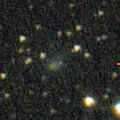
|
It brightened rapidly in outburst up to 6.9 mag (July 19, Maik Meyer). It is fading after that. Now it is 9.3 mag (Aug. 2, Katsumi Yoshimoto). It approaches to Sun down to 0.2 a.u. in August, and it was expected to brighten up to 3 mag. However, it must have been already disintegrated. Now it is not observable. In the Northern Hemisphere, it will appear in the morning sky in late October. But it will be too faint to observe.
Date(TT) R.A. (2000) Decl. Delta r Elong. m1 Best Time(A, h)
Aug. 11 8 37.19 12 48.5 0.800 0.276 11 3.9 3:42 (245,-11)
Aug. 18 9 44.18 1 29.1 1.070 0.222 11 3.6 3:50 (249,-25)
|
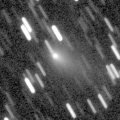
|
Now it is very bright as 7.8 mag (Aug. 12, Maik Meyer). It will brighten up to 7 mag from August to September. In the Northern Hemisphere, it will be observable in excellent condition. In the Southern Hemisphere, it will be unobservable from July to August. But it will be observable in good condition before and after that.
Date(TT) R.A. (2000) Decl. Delta r Elong. m1 Best Time(A, h)
Aug. 11 1 43.02 66 14.9 0.520 1.101 85 8.1 3:42 (188, 58)
Aug. 18 3 1.59 63 25.4 0.474 1.066 83 7.6 3:50 (198, 58)
|

|
Now it is bright as 8.9 mag (Aug. 10, Paul Camilleri). It stays bright as 8-9 mag for a while. In the Southern Hemisphere, it stays observable in good condition for a long time until the comet will fade out. In the Northern Hemisphere, it is not observable for a long time until autumn in 2019 when the comet fades out down to 16 mag.
Date(TT) R.A. (2000) Decl. Delta r Elong. m1 Best Time(A, h)
Aug. 11 14 58.25 -56 57.2 1.801 2.210 99 8.9 20:27 ( 22, -9)
Aug. 18 14 45.18 -57 21.3 1.917 2.212 92 9.1 20:16 ( 25,-11)
|
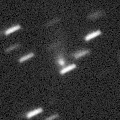
|
Now it is very bright as 9.6 mag (Aug. 8, Chris Wyatt). In the Southern Hemisphere, it is observable from July to September, but it locates in extremely low. In the Northern Hemisphere, it is not observable until late December.
Date(TT) R.A. (2000) Decl. Delta r Elong. m1 Best Time(A, h)
Aug. 11 9 16.57 -26 30.6 1.390 0.930 41 9.4 3:42 (276,-42)
Aug. 18 10 6.63 -29 10.1 1.465 0.995 42 9.8 20:16 ( 78,-38)
|

|
Now it is 9.8 mag (Aug. 11, Paul Camilleri). It will go away from Earth after this, and will fade out rapidly. It stays observable in good condition until September. It locates somewhat low in the Northern Hemisphere.
Date(TT) R.A. (2000) Decl. Delta r Elong. m1 Best Time(A, h)
Aug. 11 15 57.06 -18 17.2 0.641 1.314 102 11.2 20:27 ( 31, 31)
Aug. 18 15 31.54 -13 58.3 0.875 1.329 89 11.9 20:16 ( 43, 29)
|
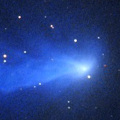
|
Now it is 10.7 mag (Aug. 9, Juan Jose Gonzalez). It stays bright as 11 mag for a long time until autumn. In the Southern Hemisphere, it is not observable for a long time after this. In the Northern Hemispehre, it stays observable for a long time until the comet fades out. But it stays very low until autumn.
Date(TT) R.A. (2000) Decl. Delta r Elong. m1 Best Time(A, h)
Aug. 11 9 53.08 52 17.4 3.520 2.784 37 11.6 20:27 (146, 13)
Aug. 18 10 15.24 51 53.0 3.524 2.810 38 11.6 20:16 (145, 13)
|

|
Now it is 11.7 mag (June 12, Juan Jose Gonzalez). It stays 12 mag for a long time until spring in 2019. In the Northern Hemisphere, it stays observable in good condition for a long time, although it becomes unobservable temporarily from mid June to August. In the Southern Hemisphere, it is not observable until September.
Date(TT) R.A. (2000) Decl. Delta r Elong. m1 Best Time(A, h)
Aug. 11 8 41.53 25 17.2 3.655 2.681 13 12.3 3:42 (235, -4)
Aug. 18 8 45.41 23 29.3 3.633 2.689 18 12.3 3:50 (241, 0)
|
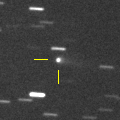
|
Now it is bright as 12.4 mag (Aug. 13, Paul Camilleri). It stays at 12-13 mag from summer to autumn. It is observable in excellent condition in the Southern Hemisphere. It locates somewhat low in the Northern Hemisphere.
Date(TT) R.A. (2000) Decl. Delta r Elong. m1 Best Time(A, h)
Aug. 11 22 42.78 -23 24.1 1.024 2.005 159 12.6 1:27 ( 0, 32)
Aug. 18 22 40.84 -24 48.6 1.015 2.005 163 12.6 0:58 ( 0, 30)
|

|
Now it is 13.6 mag (Aug. 13, Paul Camilleri). It will brighten rapidly after this, and it is expected to brighten up to 9 mag from autumn to winter. In the Northern Hemisphere, it stays observable in good condition for a long time until it fades out. In the Southern Hemispehre, it is observable in good condition until autumn, but it will be low in winter.
Date(TT) R.A. (2000) Decl. Delta r Elong. m1 Best Time(A, h)
Aug. 11 3 55.05 4 18.1 1.838 1.954 80 13.1 3:42 (297, 39)
Aug. 18 4 10.80 5 17.5 1.737 1.906 83 12.7 3:50 (300, 43)
|

|
Now it is 14.2 mag (Aug. 13, Paul Camilleri).
Date(TT) R.A. (2000) Decl. Delta r Elong. m1 Best Time(A, h)
Aug. 11 23 13.97 1 30.7 4.894 5.775 147 13.2 1:58 ( 0, 57)
Aug. 18 23 11.38 1 23.6 4.843 5.775 154 13.1 1:28 ( 0, 57)
|
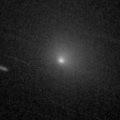
|
It brightened rapidly, and brightened up to 10.2 mag from May to June (May 22, Chris Wyatt). Now it is fading. It has already faded down to 14.0 mag (Aug. 13, Paul Camilleri). It stays observable in good condition for a long time after this. But it will be fainter than 18 mag in October.
Date(TT) R.A. (2000) Decl. Delta r Elong. m1 Best Time(A, h)
Aug. 11 1 24.12 -15 29.1 0.917 1.688 121 13.6 3:42 (352, 39)
Aug. 18 1 19.25 -14 46.7 0.920 1.744 128 14.1 3:35 ( 0, 40)
|
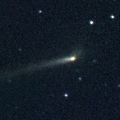
|
It brightened rapidly as predicted, and brightened up to 11.1 mag (July 13, Chris Wyatt). Now it is fading. But it is still bright as 13.0 mag (Aug. 13, Paul Camilleri). In the Southern Hemisphere, it stays observable in good condition all through this apparition. It becomes observable also in the Northern Hemisphere, but it stays low.
Date(TT) R.A. (2000) Decl. Delta r Elong. m1 Best Time(A, h)
Aug. 11 3 25.56 -35 13.6 0.288 1.092 98 13.8 3:42 (330, 12)
Aug. 18 2 43.30 -34 54.2 0.317 1.163 110 14.7 3:50 (345, 18)
|
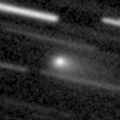
|
Now it is bright as 13.8 mag (Aug. 10, Paul Camilleri). It stays observable in good condition for a long time after this. But it will be fading gradually.
Date(TT) R.A. (2000) Decl. Delta r Elong. m1 Best Time(A, h)
Aug. 11 23 41.44 5 19.1 0.980 1.872 139 14.0 2:25 ( 0, 60)
Aug. 18 23 37.04 5 56.0 0.975 1.905 146 14.1 1:54 ( 0, 61)
|
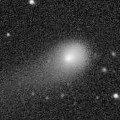
|
Now it is 12.8 mag (July 13, Seiichi Yoshida). It will be observable at 12-13 mag for a long time from 2017 to 2018. In the Southern Hemisphere, it will be hardly observable after this.
Date(TT) R.A. (2000) Decl. Delta r Elong. m1 Best Time(A, h)
Aug. 11 11 44.21 40 36.2 4.757 4.031 39 14.0 20:27 (125, 22)
Aug. 18 11 45.10 39 36.8 4.820 4.055 36 14.1 20:16 (126, 18)
|
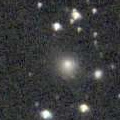
|
Now it is 14.1 mag (Aug. 11, Paul Camilleri). It stays 13-14 mag until summer in 2019. In the Northern Hemisphere, it stays observable in good condition for a while. It locates somewhat low in the Southern Hemisphere.
Date(TT) R.A. (2000) Decl. Delta r Elong. m1 Best Time(A, h)
Aug. 11 16 32.31 29 32.4 3.320 3.588 97 14.2 20:27 ( 75, 73)
Aug. 18 16 26.93 26 45.5 3.371 3.561 92 14.2 20:16 ( 74, 68)
|
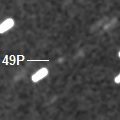
|
The condition is worst in this apparition. It brightens up to 14.5 mag from June to August, but it is not observable at all.
Date(TT) R.A. (2000) Decl. Delta r Elong. m1 Best Time(A, h)
Aug. 11 8 16.20 18 7.7 2.407 1.460 15 14.7 3:42 (244, -5)
Aug. 18 8 38.99 17 46.2 2.413 1.477 17 14.8 3:50 (246, -2)
|

|
Now it is 15.1 mag (June 18, Martin Masek). It stays 15 mag from 2018 to 2019, and it will be observable for a long time in the Southern Hemisphere. In the Northern Hemisphere, it will never be observable again.
Date(TT) R.A. (2000) Decl. Delta r Elong. m1 Best Time(A, h)
Aug. 11 12 36.49 -64 8.6 4.120 4.204 87 15.0 20:27 ( 28,-26)
Aug. 18 12 47.12 -64 17.7 4.154 4.183 84 15.0 20:16 ( 28,-27)
|
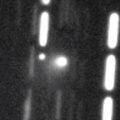
|
Now it is 13.9 mag (Aug. 11, Paul Camilleri). It stays at 14-15 mag for a long time from summer to winter. In the Southern Hemisphere, it stays observable in excellent condition for a while. But it will be getting lower rapidly in September, then it becomes unobservable after October. In the Northern Hemisphere, it stays observable for a long time until it fades out. But it stays extremely low.
Date(TT) R.A. (2000) Decl. Delta r Elong. m1 Best Time(A, h)
Aug. 11 14 11.87 -15 22.5 2.224 2.243 77 15.2 20:27 ( 55, 19)
Aug. 18 14 19.41 -13 28.4 2.273 2.189 72 15.2 20:16 ( 58, 18)
|

|
Now it is 16.3 mag (Jan. 11, ATLAS-HKO, Haleakala). It will brighten up to 14 mag in winter. It will be observable in excellent condition in the Northern Hemisphere. In the Southern Hemisphere, it is observable only until August.
Date(TT) R.A. (2000) Decl. Delta r Elong. m1 Best Time(A, h)
Aug. 11 4 8.17 35 40.8 2.171 2.090 71 15.3 3:42 (255, 52)
Aug. 18 4 22.53 38 33.6 2.079 2.066 75 15.2 3:50 (251, 56)
|

|
Now it is 16.6 mag (June 21, Kunihiro Shima). It is observable at 15 mag in 2018, in good condition in the Southern Hemisphere. It locates somewhat low in the Northern Hemisphere.
Date(TT) R.A. (2000) Decl. Delta r Elong. m1 Best Time(A, h)
Aug. 11 23 26.26 -17 36.0 2.329 3.248 150 15.3 2:10 ( 0, 38)
Aug. 18 23 22.59 -18 9.3 2.307 3.262 156 15.2 1:39 ( 0, 37)
|

|
Now it is 17.6 mag (Aug. 5, Toshihiko Ikemura, Hirohisa Sato). It will approach to Earth down to 0.08 a.u. in December, and it is expected to brighten up to 3 mag. In the Northern Hemisphere, it stays observable in excellent condition. In the Southern Hemisphere, it is observable in good condition until mid December when it brightens up to 3 mag. But it becomes unobservable after that.
Date(TT) R.A. (2000) Decl. Delta r Elong. m1 Best Time(A, h)
Aug. 11 1 8.90 -14 52.3 1.066 1.848 125 16.0 3:42 (357, 40)
Aug. 18 1 17.17 -15 45.5 0.965 1.788 129 15.4 3:33 ( 0, 39)
|

|
It brightened up to 7.1 mag from May to June in 2017 (June 21, Juan Jose Gonzalez). Now it is fading. It has already faded down to 15.0 mag (July 15, Thomas Lehmann). In the Southern Hemisphere, it stays observable for a long time after this. It will never be observable again in the Northern Hemisphere.
Date(TT) R.A. (2000) Decl. Delta r Elong. m1 Best Time(A, h)
Aug. 11 2 8.90 -50 21.6 4.595 5.083 113 15.7 3:42 (349, 3)
Aug. 18 2 7.25 -51 14.3 4.620 5.146 116 15.7 3:50 (355, 4)
|

|
Now it is 15.9 mag (July 14, iTelescope Observatory, Siding Spring). It will brighten up to 12 mag in autumn in 2019. It stays observable in good condition for a while in the Southern Hemisphere. In the Northern Hemisphere, it stays extremely low for a long time.
Date(TT) R.A. (2000) Decl. Delta r Elong. m1 Best Time(A, h)
Aug. 11 3 13.69 -42 57.2 4.642 4.952 101 15.8 3:42 (336, 6)
Aug. 18 3 12.46 -43 33.8 4.535 4.904 105 15.7 3:50 (342, 8)
|
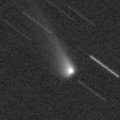
|
Now it is 16.8 mag (Aug. 5, Toshihiko Ikemura, Hirohisa Sato). Fading now. It stays observable in good condition for a long time after this in the Southern Hemisphere. It stays low in the Northern Hemisphere.
Date(TT) R.A. (2000) Decl. Delta r Elong. m1 Best Time(A, h)
Aug. 11 0 37.95 -24 40.2 3.939 4.692 133 15.7 3:22 ( 0, 30)
Aug. 18 0 30.85 -26 41.0 3.898 4.716 139 15.7 2:47 ( 0, 28)
|
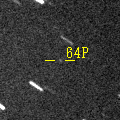
|
It brightened in outburst on Aug. 14 up to 13.6 mag (Aug. 14, Piotr Guzik). It will be observable in excellent condition in the Northern Hemisphere. It stays low in the Southern Hemisphere.
Date(TT) R.A. (2000) Decl. Delta r Elong. m1 Best Time(A, h)
Aug. 11 0 2.33 12 42.0 0.865 1.713 131 16.2 2:46 ( 0, 68)
Aug. 18 0 8.14 15 11.2 0.790 1.669 135 15.8 2:24 ( 0, 70)
|
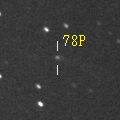
|
Now it is 14.9 mag (Aug. 8, Toshihiko Ikemura, Hirohisa Sato). It stays at 13 mag for a long time from winter to autumn in 2019. It stays observable in good condition until winter when the comet brightens up to 13 mag.
Date(TT) R.A. (2000) Decl. Delta r Elong. m1 Best Time(A, h)
Aug. 11 21 48.88 -3 34.5 1.709 2.705 166 16.1 0:33 ( 0, 52)
Aug. 18 21 43.73 -4 2.7 1.669 2.673 170 15.9 0:01 ( 0, 51)
|

|
Now it is around the apheilon. But it brightened up to 15.8 mag in outburst (July 21, Hidetaka Sato). Now it is getting diffused. But it is bright as 16.1 mag still now (Aug. 8, Toshihiko Ikemura, Hirohisa Sato).
Date(TT) R.A. (2000) Decl. Delta r Elong. m1 Best Time(A, h)
Aug. 11 21 11.98 -12 44.9 3.625 4.637 176 16.1 23:52 ( 0, 42)
Aug. 18 21 8.02 -13 5.5 3.636 4.637 170 16.3 23:21 ( 0, 42)
|
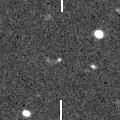
|
Now it is 17.0 mag (July 15, Toshihiko Ikemura, Hirohisa Sato). It brightens up to 16 mag from August to October. But it stays low.
Date(TT) R.A. (2000) Decl. Delta r Elong. m1 Best Time(A, h)
Aug. 11 13 7.60 1 38.1 1.818 1.530 57 16.4 20:27 ( 79, 18)
Aug. 18 13 26.43 -0 18.7 1.843 1.523 55 16.3 20:16 ( 77, 17)
|
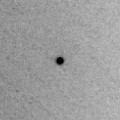
|
Now it is 16.2 mag (June 17, Jean-Francois Soulier). It stays 16 mag for a while. In the Southern Hemisphere, it stays observable until August, but it will be unobservable after that. In the Northern Hemisphere, it becomes observable in good condition after this. Its cometary activity was observed on Mar. 26 (M. Mommert, D. Polishook, N. Moskovitz).
Date(TT) R.A. (2000) Decl. Delta r Elong. m1 Best Time(A, h)
Aug. 11 2 53.82 33 37.1 1.433 1.714 87 16.4 3:42 (265, 66)
Aug. 18 2 58.45 36 42.1 1.421 1.770 91 16.4 3:50 (258, 73)
|
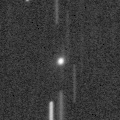
|
It brightened rapidly. Now it is 16.1 mag (Aug. 5, Toshihiko Ikemura, Hirohisa Sato). It will be fading after this, and will be fainter than 18 mag in September.
Date(TT) R.A. (2000) Decl. Delta r Elong. m1 Best Time(A, h)
Aug. 11 15 28.55 -10 24.3 1.803 2.134 94 16.5 20:27 ( 42, 34)
Aug. 18 15 38.23 -13 15.3 1.907 2.169 90 16.7 20:16 ( 42, 31)
|
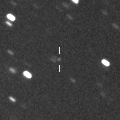
|
Now it is 16.0 mag (Aug. 12, Gabor Santa). It will be observable at 16.5 mag in good condition from August to September.
Date(TT) R.A. (2000) Decl. Delta r Elong. m1 Best Time(A, h)
Aug. 11 21 40.98 -4 34.0 1.239 2.241 168 16.7 0:25 ( 0, 51)
Aug. 18 21 36.64 -4 48.5 1.205 2.210 171 16.5 23:49 ( 0, 50)
|
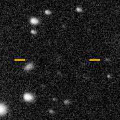
|
It will be observable at 16 mag in good condition from autumn to winter. It locates somewhat low in the Southern Hemisphere.
Date(TT) R.A. (2000) Decl. Delta r Elong. m1 Best Time(A, h)
Aug. 11 5 50.95 30 19.9 2.890 2.376 50 16.8 3:42 (252, 30)
Aug. 18 6 6.11 30 20.8 2.823 2.370 53 16.7 3:50 (254, 34)
|
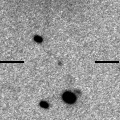
|
Now it is 16.8 mag (Aug. 8, Toshihiko Ikemura, Hirohisa Sato). It is expected to brighten up to 7-8 mag in 2020. In 2018, it will be observable at 15-16 mag in good condition from autum to winter.
Date(TT) R.A. (2000) Decl. Delta r Elong. m1 Best Time(A, h)
Aug. 11 3 59.83 -3 42.5 6.926 6.857 81 17.1 3:42 (303, 33)
Aug. 18 4 1.15 -3 48.8 6.764 6.800 87 17.0 3:50 (311, 38)
|

|
Now it is 17.1 mag (June 13, Toshihiko Ikemura, Hirohisa Sato). It will be fading gradually after this, and it will be fainter than 18 mag in winter. In the Northern Hemisphere, it stays observable in good condition for a long time. In the Southern Hemisphere, it will never be observable again.
Date(TT) R.A. (2000) Decl. Delta r Elong. m1 Best Time(A, h)
Aug. 11 23 40.42 77 24.9 7.498 7.479 85 17.1 2:24 (180, 47)
Aug. 18 23 34.69 77 40.7 7.475 7.504 87 17.2 1:51 (180, 47)
|

|
Now it is 17.3 mag (Feb. 20, Toshihiko Ikemura, Hirohisa Sato). It stays 17 mag in 2018.
Date(TT) R.A. (2000) Decl. Delta r Elong. m1 Best Time(A, h)
Aug. 11 5 2.36 5 18.1 7.790 7.409 64 17.2 3:42 (283, 27)
Aug. 18 5 5.17 5 6.4 7.725 7.443 70 17.2 3:50 (289, 33)
|
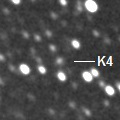
|
Now it is 17.8 mag (Aug. 8, Toshihiko Ikemura, Hirohisa Sato). It was observed at 16 mag from summer to autumn in 2017. It will be observable at 17 mag in good condition also in 2018. It locates somewhat low in the Southern Hemisphere.
Date(TT) R.A. (2000) Decl. Delta r Elong. m1 Best Time(A, h)
Aug. 11 1 11.92 27 43.7 2.907 3.384 109 17.2 3:42 (337, 82)
Aug. 18 1 12.05 28 27.4 2.866 3.425 115 17.2 3:28 ( 0, 84)
|
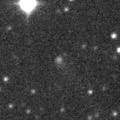
|
Now it is 16.9 mag (May 15, Toshihiko Ikemura, Hirohisa Sato). It is observable at 17.5 mag until September. But it will be getting lower gradually.
Date(TT) R.A. (2000) Decl. Delta r Elong. m1 Best Time(A, h)
Aug. 11 14 31.20 -2 30.0 6.789 6.661 78 17.4 20:27 ( 61, 31)
Aug. 18 14 33.30 -2 21.7 6.919 6.683 72 17.4 20:16 ( 64, 28)
|

|
Now it is 17.1 mag (July 13, Toshihiko Ikemura, Hirohisa Sato). It is not observable after this in the Southern Hemisphere. It is observable in good condition in the Northern Hemisphere. But it will be fainter than 18 mag in September.
Date(TT) R.A. (2000) Decl. Delta r Elong. m1 Best Time(A, h)
Aug. 11 3 47.09 47 30.8 1.252 1.384 74 17.4 3:42 (235, 57)
Aug. 18 4 11.53 51 52.9 1.271 1.421 76 17.5 3:50 (227, 57)
|

|
First return of a new periodic comet which brightened up to 16.5 mag in 2005. Now it is 19.1 mag (June 14, E. Schwab, D. Abreu). It will be observable at 17 mag in good condition in autumn. It locates low in the Southern Hemisphere.
Date(TT) R.A. (2000) Decl. Delta r Elong. m1 Best Time(A, h)
Aug. 11 1 26.50 30 40.2 1.583 2.093 105 17.7 3:42 (304, 83)
Aug. 18 1 34.62 31 58.5 1.515 2.084 109 17.6 3:50 (357, 87)
|

|
First return of a new periodic comet which brightened up to 17 mag in 2008. It was predicted to brighten up to 18 mag in autumn. But actually, it is much fainter than predicted, fainter than 21.5 mag (June 22, Erwin Schwab).
Date(TT) R.A. (2000) Decl. Delta r Elong. m1 Best Time(A, h)
Aug. 11 23 21.04 -0 15.8 2.933 3.823 146 17.9 2:05 ( 0, 55)
Aug. 18 23 17.76 -0 19.3 2.884 3.821 154 17.8 1:34 ( 0, 55)
|
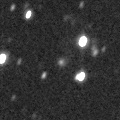
|
Now it is 17.7 mag (Aug. 8, Toshihiko Ikemura, Hirohisa Sato). It is expected to be observable at 5-6 mag for a long time from 2022 to 2023. It will be observable in good condition for a long time in the Southern Hemisphere. In the Northern Hemisphere, it is not observable at the highlight from 2022 summer to 2023 summer.
Date(TT) R.A. (2000) Decl. Delta r Elong. m1 Best Time(A, h)
Aug. 11 17 12.44 59 51.5 13.405 13.438 89 17.9 20:27 (170, 65)
Aug. 18 17 10.62 59 20.7 13.380 13.395 88 17.9 20:16 (164, 64)
|
|
![]()
 C/2016 R2 ( PanSTARRS )
C/2016 R2 ( PanSTARRS ) C/2016 N6 ( PanSTARRS )
C/2016 N6 ( PanSTARRS ) 48P/Johnson
48P/Johnson 38P/Stephan-Oterma
38P/Stephan-Oterma 29P/Schwassmann-Wachmann 1
29P/Schwassmann-Wachmann 1 66P/du Toit
66P/du Toit 364P/2018 A2 ( PanSTARRS )
364P/2018 A2 ( PanSTARRS ) 37P/Forbes
37P/Forbes C/2015 O1 ( PanSTARRS )
C/2015 O1 ( PanSTARRS ) C/2017 M4 ( ATLAS )
C/2017 M4 ( ATLAS ) 49P/Arend-Rigaux
49P/Arend-Rigaux C/2017 B3 ( LINEAR )
C/2017 B3 ( LINEAR ) C/2018 L2 ( ATLAS )
C/2018 L2 ( ATLAS ) (944) Hidalgo
(944) Hidalgo 65P/Gunn
65P/Gunn 46P/Wirtanen
46P/Wirtanen C/2015 V2 ( Johnson )
C/2015 V2 ( Johnson ) C/2018 N2 ( ASASSN )
C/2018 N2 ( ASASSN ) C/2015 V1 ( PanSTARRS )
C/2015 V1 ( PanSTARRS ) 64P/Swift-Gehrels
64P/Swift-Gehrels 78P/Gehrels 2
78P/Gehrels 2 129P/Shoemaker-Levy 3
129P/Shoemaker-Levy 3 125P/Spacewatch
125P/Spacewatch (3552) Don Quixote
(3552) Don Quixote C/2018 C2 ( Lemmon )
C/2018 C2 ( Lemmon ) 137P/Shoemaker-Levy 2
137P/Shoemaker-Levy 2 59P/Kearns-Kwee
59P/Kearns-Kwee C/2017 T2 ( PanSTARRS )
C/2017 T2 ( PanSTARRS ) C/2014 OE4 ( PanSTARRS )
C/2014 OE4 ( PanSTARRS ) C/2011 KP36 ( Spacewatch )
C/2011 KP36 ( Spacewatch ) C/2017 K4 ( ATLAS )
C/2017 K4 ( ATLAS ) C/2017 E3 ( PanSTARRS )
C/2017 E3 ( PanSTARRS ) C/2018 M1 ( Catalina )
C/2018 M1 ( Catalina ) P/2018 L3 ( NEAT )
P/2018 L3 ( NEAT ) P/2008 O2 ( McNaught )
P/2008 O2 ( McNaught ) C/2017 K2 ( PanSTARRS )
C/2017 K2 ( PanSTARRS )![]()































